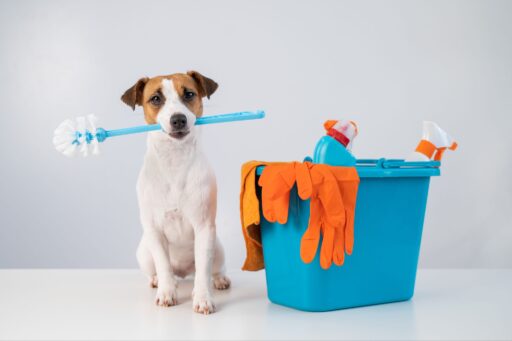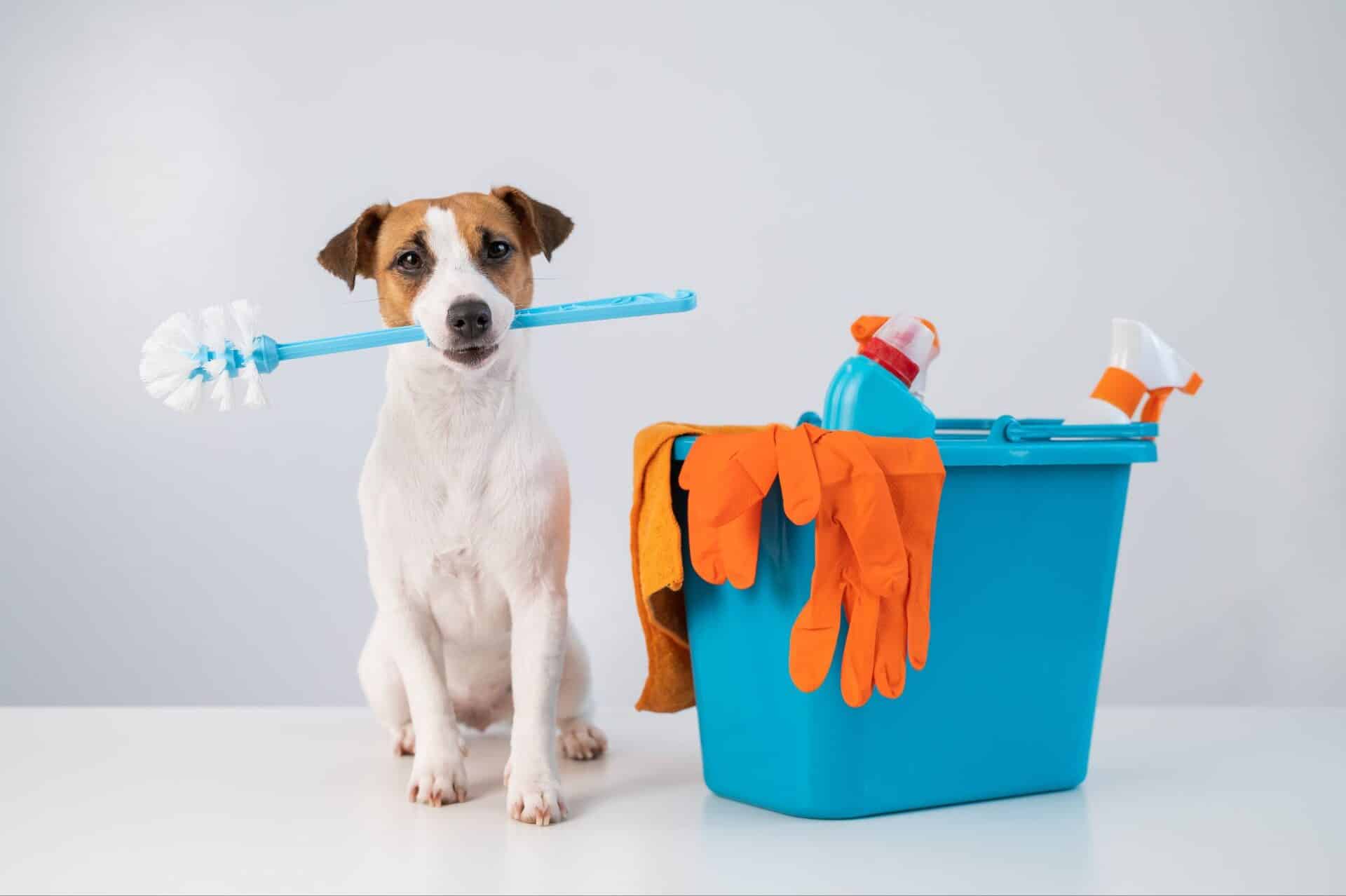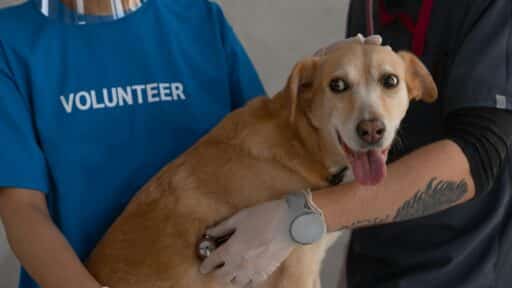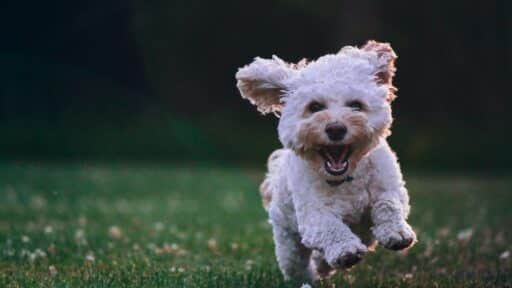Living with a dog brings endless joy, loyalty, and companionship–but it also comes with muddy paws, shedding fur, and the occasional mess around the house. Many owners struggle to balance the comfort of having pets with the challenge of keeping their homes or apartments clean and fresh. The good news is that with the right habits, smart cleaning hacks, and preventive strategies, it’s absolutely possible to enjoy a tidy living space without compromising your dog’s happiness.
In this guide, you’ll discover practical tips on daily cleaning routines, grooming, pet zone organization, and small adjustments that make a big difference. And if you’re looking for reliable helpers, check out Potty Buddy – pet accessories designed to keep your home clean and your furry friend comfortable.
Smart Home Setup to Minimize the Mess
A clean home starts with smart choices in your interior design. By setting up your space in a way that minimizes dirt and fur build-up, you make daily cleaning much easier and prevent long-term wear from your dog’s habits. Small adjustments to flooring, furniture, and finishes can go a long way in helping you keep your house clean with a dog.
Flooring: Choosing Practical Surfaces That Are Easy to Clean
Flooring is one of the first things that collects paw prints, fur, and occasional spills. If you’re renovating or updating your home, opt for surfaces that are durable and simple to wipe down. Tiles, vinyl, or laminate floors are excellent because they resist stains and odors and can be quickly mopped. If you love the warmth of rugs, choose washable ones designed for homes with pets. Keeping a washable mat at the entrance also helps catch dirt from your dog’s paws before it spreads across the apartment.
Furniture & Upholstery: Fabrics That Don’t Trap Fur and Odors
Your dog will likely spend time on the sofa or armchair, so choosing the right upholstery matters. Leather or faux leather is easier to wipe clean than fabric and doesn’t trap fur. If you prefer fabric, go with tightly woven options that resist odors and are less prone to collecting pet hair. Washable slipcovers or pet blankets can also protect your furniture while keeping things tidy. Place a dedicated pet bed nearby–this way, your dog has a comfortable spot while you maintain order in shared spaces.
Walls & Finishes: Protective, Washable Options
Dogs can brush against walls, leave marks, or even shake off muddy fur after a walk. To reduce visible stains, paint walls with washable, scrubbable finishes that let you clean without damaging the color. In high-traffic areas like hallways or near your dog’s feeding zone, consider protective wall panels or easy-to-wipe materials. This small upgrade makes it simpler to maintain cleanliness in the house with pets while keeping your home looking fresh.
Grooming and Hygiene Routines
Keeping your home clean with a dog isn’t only about vacuuming and wiping floors–it starts with your pet’s hygiene. A well-groomed dog naturally brings less dirt, fur, and odors into your living space. By following a consistent routine, you can minimize shedding, prevent mess after walks, and keep your dog healthier overall.
Regular Brushing to Reduce Shedding
One of the simplest ways to reduce fur around the house is by brushing your dog regularly. Short-haired breeds may only need a quick brush a few times a week, while long-haired dogs often require daily care. Brushing removes loose hair before it falls onto your carpets and furniture, and it also prevents mats that can trap dirt and odors. Make brushing a bonding routine–it helps with cleanliness and strengthens your connection with your pet.
Bathing Schedule & Paw Cleaning After Walks
Dogs don’t need daily baths, but sticking to a schedule–about once every 4–6 weeks depending on breed and activity level–keeps their coat fresh and reduces unwanted smells. Always use shampoos designed for dogs to avoid skin irritation. In between baths, paw cleaning is essential. Wiping your dog’s paws after every walk prevents mud, dust, or allergens from spreading across your apartment. Keep a small towel or pet wipes near the door for quick clean-ups.
Tick, Flea, and Parasite Protection
Hygiene isn’t just about visible dirt–it’s also about protecting your dog from pests that can affect both their health and the cleanliness of your home. Regular treatments against fleas, ticks, and other parasites reduce scratching, shedding, and potential infestations indoors. Consult your vet to choose the best preventive method, whether it’s spot-on treatments, collars, or oral medication. Staying consistent with parasite protection keeps both your dog and your household safe.
Daily Cleaning Habits That Work
Even with the best grooming routines, dogs naturally bring a bit of the outside world indoors. The key to keeping your apartment clean with a dog is consistency. Small, regular habits prevent dirt, fur, and odors from building up, making home maintenance much easier.
Setting a Cleaning Schedule (Vacuuming, Mopping, Airing Out)
Creating a simple routine helps you stay on top of the mess. Daily or every-other-day vacuuming in high-traffic areas keeps fur and dust under control. A quick mop once or twice a week removes paw prints and allergens, especially if your dog spends time outdoors. Don’t forget to open windows for fresh air–ventilation is one of the easiest ways to prevent lingering pet odors and keep your living space feeling clean.
Best Vacuum Cleaners, Lint Rollers, and Fur-Removal Tools
Investing in the right tools saves time and energy. Pet-friendly vacuum cleaners with HEPA filters are excellent for trapping fur and dander, while handheld vacuums help with quick spot clean-ups. Lint rollers and reusable fur-removal brushes are must-haves for clothes, couches, and car seats.
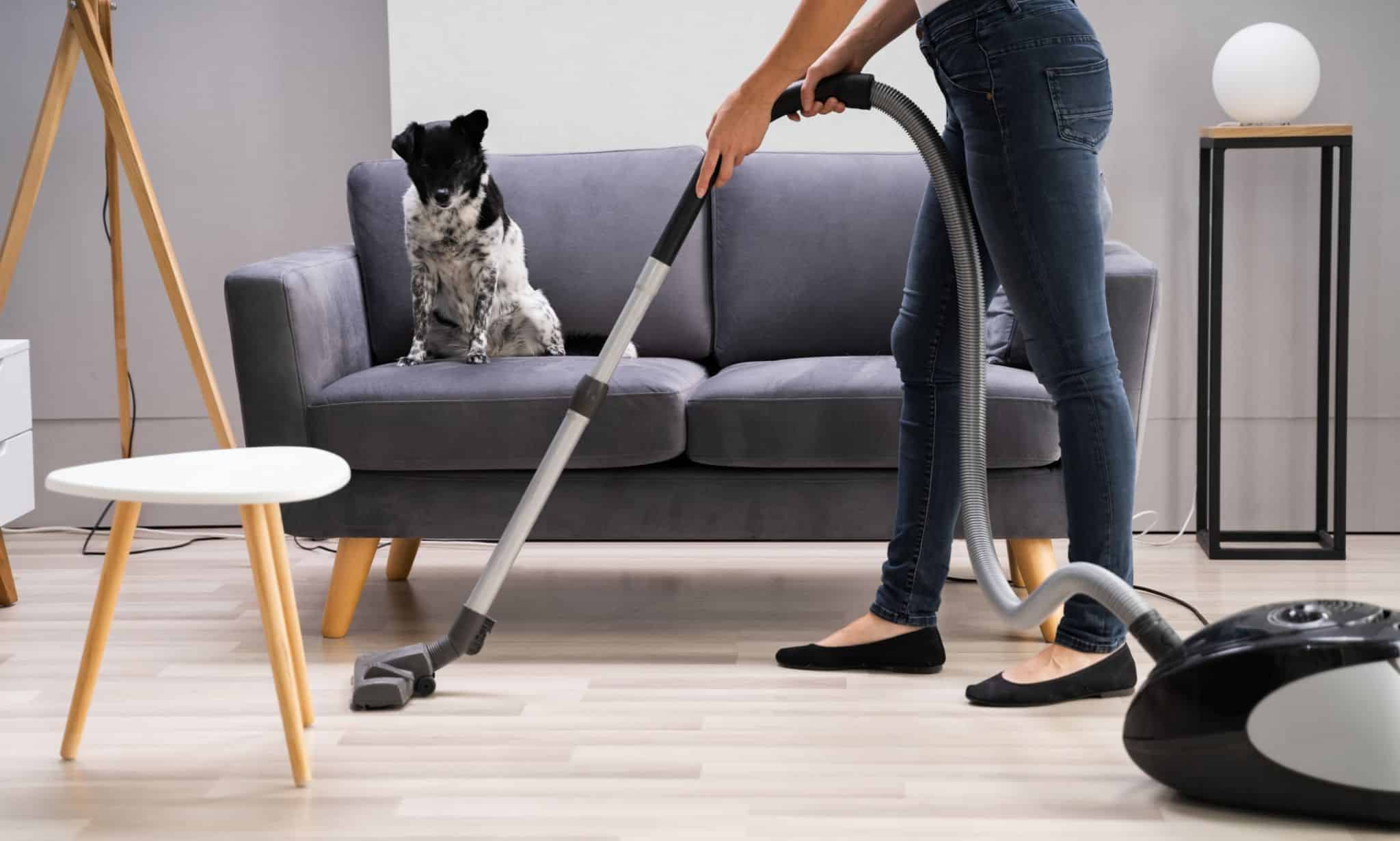
If you want to make the process even easier, consider getting a robot vacuum. These devices are especially useful in homes with shedding dogs, as they can run daily and collect fur, dust, and crumbs without extra effort from you. Many models are designed with strong suction and anti-tangle brushes, making them well-suited for managing pet hair on both hard floors and carpets. Having a robot vacuum take care of the routine allows you to focus on other parts of home cleaning.
Keeping Stain and Odor Removers Handy
Accidents happen–even the most well-trained dogs may leave a surprise once in a while. That’s why it’s smart to keep stain and odor removers close at hand. Enzyme-based sprays break down organic messes, helping prevent odors from setting in. For example, Potty Buddy’s Cleaning Spray can be useful for quickly neutralizing accidents on carpets or furniture. Acting fast ensures your home stays fresh, and it also discourages repeat accidents in the same spot.
Solving the Common Problem Areas
Even with a cleaning routine in place, some pet-related messes keep showing up in every home. Knowing how to handle these problem areas makes life easier and helps you keep your house clean with a dog.
Dirty Paws and Entryway Mess
One of the biggest sources of dirt indoors is muddy or wet paws after walks. To reduce the mess, set up a small “entryway station” near your door with a washable mat, a towel, and pet-safe wipes. Train your dog to pause here before entering fully, and wipe their paws every time. This habit not only keeps your floors cleaner but also prevents allergens and outdoor bacteria from spreading inside.
Fur on Carpets, Upholstery, and Clothes
Shedding fur finds its way into every corner, especially on soft surfaces. Regular vacuuming helps, but having quick tools like lint rollers, rubber grooming gloves, or fabric brushes nearby makes a huge difference. On carpets and upholstery, run the vacuum more often in areas where your dog spends the most time. Washable throws or blankets on the couch can also serve as a barrier, making fur removal much easier.
Stains and Spills
Accidents and spills are inevitable when living with pets. The key is to act quickly. Blot up any liquid before it sets, and then use an enzyme-based cleaner to break down stains fully. Avoid harsh chemical products that can be harmful to your dog. Keeping a dedicated cleaning spray in the kitchen or entryway ensures you can handle accidents immediately, before they leave a permanent mark.
Pet-Related Odors (How to Prevent and Neutralize)
Odors can build up even in the cleanest homes if you don’t tackle them at the source. Regular grooming and washing of pet bedding are essential. Ventilate rooms daily to refresh the air, and use washable covers for cushions or blankets. For tougher odors, enzyme cleaners are more effective than air fresheners, since they neutralize the smell instead of masking it. Washing food and water bowls often also helps reduce unwanted smells around your dog’s feeding area.
Organizing Pet Zones at Home
Creating designated spaces for your dog not only helps your pet feel comfortable but also makes it easier to keep your apartment clean and organized. When your dog has specific zones for resting, eating, and playing, it reduces the spread of fur, dirt, and odors across the house.
Designated Sleeping/Resting Spots
Every dog needs a cozy, secure place to rest. Setting up a dedicated bed or mat for your pet helps contain shedding and dirt in one area, instead of letting it spread across sofas and carpets. Choose washable dog beds or use removable covers that can be thrown in the washing machine. Placing the bed in a quiet corner also gives your dog a sense of security while keeping shared furniture cleaner.
Feeding and Drinking Area Hygiene
The feeding zone can quickly become messy with spilled water, crumbs, and food odors. To keep it clean, place bowls on a washable mat or tray that can catch drips and prevent stains on the floor. Stainless steel or ceramic bowls are better than plastic because they resist odors and are easier to sanitize. Make a habit of rinsing your dog’s bowls daily and giving them a deep clean at least once a week to prevent bacteria build-up.
Using Crates, Pens, or Washable Blankets
Crates and pens can be useful not just for training but also for maintaining order in the house. They create boundaries and give your dog a safe, controlled space when needed. For added cleanliness, line these areas with washable blankets or pads that can be swapped out regularly. Washable covers or throws can also be placed on couches and chairs if your dog likes to snuggle there, making cleanup faster and easier.
Training for a Cleaner Home
Cleanliness in the house isn’t only about your effort–it also depends on your dog’s behavior. Teaching your pet simple habits can significantly reduce the mess and make home care easier in the long run. With patience and positive reinforcement, your dog can learn routines that support a cleaner living space.
Teaching Your Dog Basic “Clean House” Habits
Start with simple rules that directly impact household hygiene. Train your dog not to chew on furniture, shoes, or household items by offering suitable chew toys instead. Discourage marking indoors by taking your dog outside frequently and rewarding them for doing their business in the right place. Another useful habit is wiping paws: teach your dog to wait calmly at the door while you clean their feet after a walk. These small steps prevent damage and mess before they start.
Reward-Based Reinforcement for Good Behavior
Positive reinforcement is the most effective way to encourage clean habits. Praise, treats, or playtime rewards help your dog associate good behavior with pleasant outcomes. For example, if your dog patiently waits to have their paws wiped, reward them with a small treat. Consistency is key – when your dog knows what to expect, they’re more likely to follow the routine. Over time, these behaviors become second nature, making it easier to maintain order and cleanliness at home.
Final Tips: Living Comfortably with Pets and Clean Spaces
Keeping a home clean with a dog doesn’t have to feel overwhelming. With a few smart adjustments, you can enjoy both a tidy living space and the joy of a happy pet. Remember the key strategies: choose easy-to-clean surfaces, stick to regular grooming routines, stay consistent with daily cleaning habits, and address common problem areas like dirty paws, fur, and odors right away. Organizing pet zones and reinforcing good behavior through training also go a long way in reducing everyday mess.
Living with dogs means accepting a little extra fur and the occasional muddy pawprint–but it doesn’t mean giving up on comfort or cleanliness. A fresh, organized home and a content, well-cared-for dog can absolutely coexist.
Start small: wipe paws after walks, vacuum a little more often, keep a cleaning spray within reach, and encourage your dog’s good habits with positive reinforcement. These simple daily actions add up, making your home feel fresher, cleaner, and more welcoming–for both your family and your four-legged friend.

